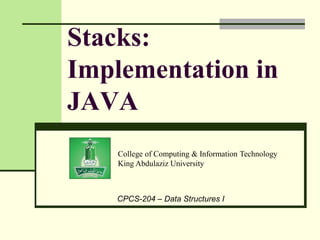The document provides an overview of stacks as an abstract data type in computer science, focusing on their principles and implementation in Java. It explains the last-in, first-out (LIFO) access policy, basic operations including push and pop, and methods to check if a stack is empty or full. The document further explores two implementations of stacks: one using arrays and another using linked lists, detailing how to restrict their functionalities to behave like stacks.









![Stacks: Implementation in JAVA page 10
© Dr. Jonathan (Yahya) Cazalas
Stacks: Implementation in JAVA
Array Implementation of Stacks:
Here is our class, StackArray:
maxSize clearly represents the max number of items in
the stack
If the stack becomes full, at that point, the top item will
be stored at index ‘maxSize-1’
public class StackArray {
private int[] stack;
private int top;
private int maxSize;
// Constructor and Methods here
}](https://image.slidesharecdn.com/cpcs20415stacks2-210408140648/85/stacks2-10-320.jpg)
![Stacks: Implementation in JAVA page 11
© Dr. Jonathan (Yahya) Cazalas
Stacks: Implementation in JAVA
Array Implementation of Stacks:
Here is the constructor:
So we set maxSize from the parameter size
We then make the new array, stack
Finally, we set top equal to -1
Why?
class StackArray {
...
public StackArray(int size) {
maxSize = size;
stack = new int[maxSize];
top = -1;
}](https://image.slidesharecdn.com/cpcs20415stacks2-210408140648/85/stacks2-11-320.jpg)
![Stacks: Implementation in JAVA page 12
© Dr. Jonathan (Yahya) Cazalas
Stacks: Implementation in JAVA
Array Implementation of Stacks:
Here is the constructor:
When the stack has one element, what is saved in top?
top is the index to the “top element”
So if there is only one element, that element is at index zero!
So top will have the value, 0, referring to the first cell
class StackArray {
...
public StackArray(int size) {
maxSize = size;
stack = new int[maxSize];
top = -1;
}](https://image.slidesharecdn.com/cpcs20415stacks2-210408140648/85/stacks2-12-320.jpg)
![Stacks: Implementation in JAVA page 13
© Dr. Jonathan (Yahya) Cazalas
Stacks: Implementation in JAVA
Array Implementation of Stacks:
Here is the constructor:
So when top is zero, that means we have ONE element
How do we show that the stack is empty???
We set top equal to -1
This means that nothing is in the stack.
class StackArray {
...
public StackArray(int size) {
maxSize = size;
stack = new int[maxSize];
top = -1;
}](https://image.slidesharecdn.com/cpcs20415stacks2-210408140648/85/stacks2-13-320.jpg)




![Stacks: Implementation in JAVA page 18
© Dr. Jonathan (Yahya) Cazalas
Stacks: Implementation in JAVA
Array Implementation of Stacks:
push:
To push an element, increment top to point to the next
space in the stack
Then we simply copy the value into this new top position
Here’s the code:
public void push(int value) {
if (isFull())
System.out.println(“Cannot PUSH; stack is full.”);
else
stack[++top] = value;
}](https://image.slidesharecdn.com/cpcs20415stacks2-210408140648/85/stacks2-18-320.jpg)

![Stacks: Implementation in JAVA page 20
© Dr. Jonathan (Yahya) Cazalas
Stacks: Implementation in JAVA
Array Implementation of Stacks:
pop:
To pop an element, we simply return the top item in the
stack and then decrement top
Here’s the code:
public int pop() {
if (isEmpty())
System.out.println(“Cannot POP; stack is empty.”);
else
return stack[top--];
}](https://image.slidesharecdn.com/cpcs20415stacks2-210408140648/85/stacks2-20-320.jpg)

![Stacks: Implementation in JAVA page 22
© Dr. Jonathan (Yahya) Cazalas
Stacks: Implementation in JAVA
Array Implementation of Stacks:
top:
Simply returns the top item in the stack
Here’s the code:
public int top() {
if (isEmpty())
System.out.println(“Cannot TOP; stack is empty.”);
else
return stack[top];
}](https://image.slidesharecdn.com/cpcs20415stacks2-210408140648/85/stacks2-22-320.jpg)
























